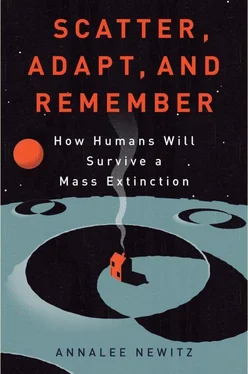Looked at from the perspective of Neanderthals, then, there might have been a vast gulf between themselves and the newly arrived H. sapiens . The newcomers not only looked different—they were taller, slimmer, and had smaller skulls—but they probably chattered in an incomprehensibly complex language and wore bizarre garments. Would Neanderthals have tried to communicate with these people, or invited them to a dinner of mammoth meat?
For anthropologists like Klein, who spoke about a Neanderthal holocaust, the answer is an emphatic no. He’s part of a school of anthropological thought that holds that H. sapiens would have met the Neanderthals with nothing but hate, disgust, and indifference to their plight. After those Neanderthals watched H. sapiens arrive, the next chapter in their lives would have been marked by bloodshed and starvation as H. sapiens murdered and outhunted them with their superior weaponry. Neanderthals were so poor, and had such a small population, that their extinction was inevitable.
This story might sound familiar to anyone versed in the colonial history of the Americas. It’s as if H. sapiens is playing the role of Europeans arriving in their ships, and Neanderthals are playing that of the soon-to-be-exterminated natives. But Klein sees a sharp contrast between Neanderthals and the natives that Europeans met in America. When H. sapiens arrived, he asserted, “there was no cultural exchange” because the Neanderthals had no culture. Imagine what might have happened if the Spanish had arrived in the Americas, but the locals had no wealth, science, sprawling cities, nor vast farms. The Neanderthals had nothing to trade with H. sapiens, and so the newcomers saw them as animals. Neanderthals may have had fleeting sexual relationships with H. sapiens here and there, admitted Klein, but “modern human males will mate with anything.” Tattersall agreed. “Maybe there was some Pleistocene hanky-panky,” he joked. But it wasn’t a sign of cultural bonding. For anthropologists like Klein and Tattersall, any noncombative relationships forged between the two human groups were more like fraternization than fraternity.
But there is a counter-narrative told by a new generation of anthropologists. Bolstered by genetic discoveries that have revealed traces of Neanderthal genes in the modern human genome, these scientists argue that there was a lot more than hanky-panky going on. Indeed, there is evidence that the arrival of H. sapiens may have dramatically transformed the impoverished Neanderthal culture. Some Neanderthal cave sites hold a mixture of traditional Neanderthal tools and H. sapiens tools. It’s hard to say whether these remains demonstrate an evolving hybrid culture, or if H. sapiens simply took over Neanderthal caves and began leaving their garbage in the same pits that the Neanderthals once used. Still, many caves that housed Neanderthals shortly before the group went extinct are full of ornaments, tools, and even paints. Were they emulating their H. sapiens counterparts? Had they become part of an early human melting pot, engaging in the very cultural exchange that Klein and Tattersall have dismissed?
Extermination and Assimilation
The complicated debate over what happened to Neanderthals can be boiled down to two dominant theories: Either H. sapiens destroyed the other humans, or joined up with them.
The “African replacement” theory, sometimes called the recent African origins theory, holds that H. sapiens charged out of Africa and crushed H. neanderthalensis underfoot. This fits with Klein’s account of a Neanderthal holocaust. Basically, H. sapiens groups replaced their distant cousins, probably by making war on them and taking over their territories. This theory is simple, and has the virtue of matching the archaeological evidence we find in caves where Neanderthal remains are below those of H. sapiens , as if modern humans pushed their Neanderthal counterparts out into the cold to die.
In the late 1980s, a University of Hawaii biochemist named Rebecca Cann and her colleagues found a way to support the African replacement theory with genetic evidence, too. Cann’s team published the results of an exhaustive study of mitochondrial DNA, small bits of genetic material that pass unchanged from mothers to children. They discovered that all humans on Earth could trace their genetic ancestry back to a single H. sapiens woman from Africa, nicknamed Mitochondrial Eve. If all of us can trace our roots back to one African woman, then how could we be the products of crossbreeding? We must have rolled triumphantly over the Neanderthals, spreading Mitochondrial Eve’s DNA everywhere we went. But mitochondrial DNA offers us only a small part of the genetic picture. When scientists sequenced the full genomes of Neanderthals, they discovered several DNA sequences shared by modern humans and their Neanderthal cousins.
Besides, how likely is it that a group of H. sapiens nomads would attack a community of Neanderthals? These were explorers, after all, probably carrying their lives on their backs. Neanderthals may not have had a lot of tools, but they did have deadly spears they used to bring down mammoths. They had fire. Even with H. sapiens ’ greater numbers, would these interlopers have had the resources to mount a civilization-erasing attack? Rather than starting a resource-intensive war against their neighbors, many H. sapiens could have opted to trade with the odd-looking locals, and eventually move in next to them. Over time, through trade (and, yes, the occasional battle) the two groups would have shared so much culturally and genetically that it would become impossible to tell them apart.
This is precisely the kind of thinking that animates what’s called the multiregional theory of human development. Popularized by Wolpoff and his colleague John Hawks, this theory fits with the same archaeological evidence that supports the African replacement theory—it’s just a very different interpretation.
Wolpoff’s idea hinges on the notion that the ancestors of Neanderthals and H. sapiens didn’t leave Africa as distinct groups, never to see each other again until the fateful meeting that Klein described with such horror. Instead, Wolpoff suggests, humans leaving Africa 1.8 million years ago forged a pathway that many other archaic humans walked—in both directions. Instead of embarking on several distinct migrations off the continent, humans expanded their territories little by little, essentially moving next door to their old communities rather than trekking thousands of kilometers to new homes. Indeed, the very notion of an “out of Africa” migration is based on an artificial political boundary between Africa and Asia, which would have been meaningless to our ancestors. They expanded to fill the tropical forests they loved, which happened to stretch across Africa and Asia during many periods in human evolution. Early humans would have been drifting back and forth between Africa, Asia, and Europe for hundreds of thousands of years. It was all just forest to Neanderthals and H. sapiens .
If scientists like Wolpoff are right—and Hawks has presented compelling genetic evidence to back them up—then H. sapiens probably didn’t march out of Africa all at once and crush all the other humans. Instead, they evolved all over the world through an extended kinship network that may have included Neanderthals as well as other early humans like Denisovans and H. erectus .
It’s important to understand that the multiregional theory does not suggest that two or three separate human lineages evolved in parallel, leading to present-day racial groups. That’s a common misinterpretation. Multiregionalism describes a human migration scenario similar to those we’re familiar with among humans today, where people cross back and forth between regions all the time. For multiregionalists, there were never two distinct waves of immigration, with one leading to Neanderthals, and the other packed with H. sapiens hundreds of thousands of years later. Instead, the migration (and evolution) of H. sapiens started 1.8 million years ago and never stopped.
Читать дальше






![Аннали Ньюиц - Автономность [litres]](/books/424681/annali-nyuic-avtonomnost-litres-thumb.webp)





